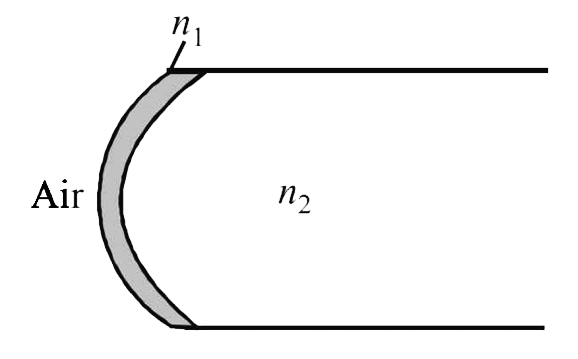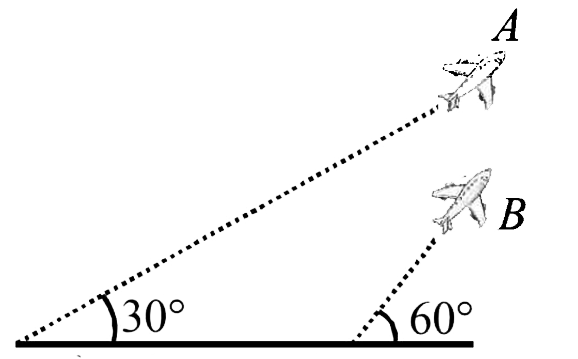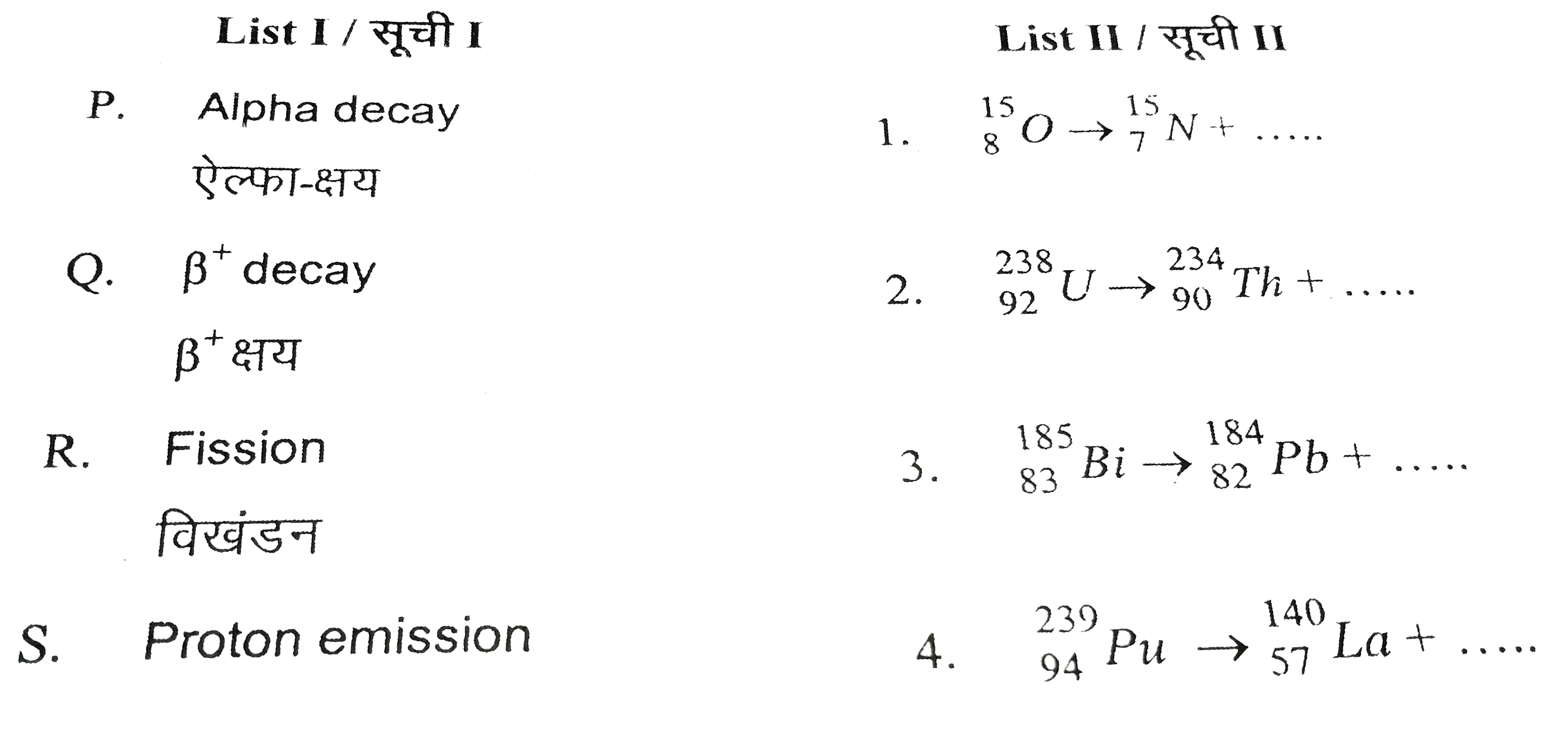A transparent thin film of uniform thickness and refractive index is coated on the convex spherical surface of radius R at one end of a long solid glass cylinder of refractive index , as shown in the figure. Rays of light parallel to the axis of the cylinder traversing through the film from air to glass get focused at distance from the film, while rays of light traversing from glass to air get focused at distance from the film, Then

The correct Answer is:A, C
Step by step video & image solution for A transparent thin film of uniform thickness and refractive index n_(1)=1.4 is coated on the convex spherical surface of radius R at one end of a long solid glass cylinder of refractive index n_(2)=1.5, as shown in the figure. Rays of light parallel to the axis of the cylinder traversing through the film from air to glass get focused at distance f_(1) from the film, while rays of light traversing from glass to air get focused at distance f_(2) from the film, Then by Physics experts to help you in doubts & scoring excellent marks in Class 12 exams.
Topper's Solved these Questions
- BOOK - JEE ADVANCED PREVIOUS YEARCHAPTER - JEE ADVANCEDEXERCISE - SECTION -2 ( ONE INTEGER VALUES CORRECT TYPE)10videos
JEE ADVANCED
- BOOK - JEE ADVANCED PREVIOUS YEARCHAPTER - JEE ADVANCEDEXERCISE - SECTION - 1 (ONLY ONE OPTION CORRRECT TYPE)10videos
JEE ADVANCED
- BOOK - JEE ADVANCED PREVIOUS YEARCHAPTER - JEE ADVANCEDEXERCISE - PART I: PHYSICS Section-3:(Matching List Type)2videos
JEE ADVANCED
- BOOK - JEE ADVANCED PREVIOUS YEARCHAPTER - JEE (ADVANCE) 2020EXERCISE - SECTION 36videos
JEE (ADVANCE) 2020
- BOOK - JEE ADVANCED PREVIOUS YEARCHAPTER - JEE ADVANCED 2020EXERCISE - SECTION-36videos
JEE ADVANCED 2020
Similar Questions
Airplanes A and B are flying with constant velocity in the same vertical plane at angles 30∘ and 60∘ with respect to the horizontal respectively as shown in figure . The speed of A is 100√3m/s . At time t=0s, an observer in A finds B at a distance of 500m. The observer sees B moving with a constant velocity perpendicular to the line of motion of A . If at t=t0, A just escapes being hit by B,t0 , A just escapes being hit by B,t0 in seconds is
 03:33View Solution
03:33View SolutionA tennis ball dropped on a barizoontal smooth surface , it because back to its original postion after hiting the surface the force on the bell during the collision is propertional to the length of compression of the bell . Which one of the following skethes desches discribe the variation of its kinetic energy K with time 1 mass apporiandly ? The figure as only illistrative and not to the scale .
03:28View SolutionMatch List I of the nuclear processes with List II containing parent nucleus and one of the end products of each process and then select the correct answer using the codes given below the lists :
 05:25View Solution
05:25View SolutionA spherical bubbles inside water has radius R . Take the pressuere in the bubbled and the water pressure to be pv. The bubble now gets compressed radially in an adiabatic manner so that its raduis becomes (R - a) . For a<<R the magnitude of the work done in the process is given by (4πpoRa2)X. where X is a a constant and y=Cp/Cv=41/30. The value of X is
06:13View SolutionPut a unifrom meter scale horizontally on your extended index fingers with the left one at 0.0 cm and the right one at 90.00 cm when you attempt to move both the fingers slowly towards the center , initially only the left finger slips with respect to to the scale and the right finger does not . after some distance, the left finger stops and the right one starts slipping . Then the right finger stops at a distance XR from the center (50.00 cm ) of the scale and the left one starts slopping again . This happens because to the difference in the fiictional forces on the two fingers . it the coefficients of static and dynamic between the fingers and the scale are 0.4 and 0.32 respectively , the value of XR (in cm is ...........
01:56View SolutionA transparent thin film of uniform thickness and refractive index n1=1.4 is coated on the convex spherical surface of radius R at one end of a long solid glass cylinder of refractive index n2=1.5, as shown in the figure. Rays of light parallel to the axis of the cylinder traversing through the film from air to glass get focused at distance f1 from the film, while rays of light traversing from glass to air get focused at distance f2 from the film, Then
 02:22View Solution
02:22View SolutionA thin uniform film of refractive index 1.75 is placed on a sheet of glass of refractive index 1.5. At room temperature (20∘C) this film is just thick enoungh for light with wavelength 600 nm reflected off the top of the film to be canceled by light reflected from the top the glass. After the glass is placed in on oven and slowly heated to 170∘C, the film conceals reflected light with wavelength 606 nm. The coefficient of linear expansion of the film is (ignore any changes in the refractive index of the film due to the temperature change)
05:18View SolutionA thin film of a specific meterial can be used to decrease the intensity of reflected light. There is destrucive inteference of wave reflected from upper and lower surface of the film. These films are called non-reflecting or anti-reflecting coatings. The process of coating the lens or surface with non-reflecting film is called blooming as shown in figure The refracting index of coating (n_(1)) is less than that of the glass (n_(2)) . 6. If the thickness of film in above question in not technologically possible to manufacture, then next thickness of film required is (approximately)
03:24View Solutionप्रकाश की एक किरण जो काँच (अपवर्तनांक, .ang=3/2) में संचरण कर रही है, एकक्षैतिज काँच-वायु अंतरापृष्ठ पर क्रांतिक कोण - पर आपतित होती है। यदि काँच-वायु अंतरापृष्ठ पर जल (अपवर्तनांक .anw=4/3) की एक पतली तह डाल दी जाये, तो प्रकाश की यह किरण जल-वायु अंतरापृष्ठ से वायु में किस कोण पर निकलेगी?
View Solutionउस पारदर्शी फिल्म की मोटाई बातएं जो लम्बवत जाते प्रकाश के प्रकाशीय पथ λ/2 में का परिवर्तन ले आए, जहाँ λ प्रकाश का तरंगदैर्घ्य है । फिल्म का अपवर्तनांक n है ।
05:25View SolutionA water film is formed on a glass block . A light ray is incident on water film from air at an angle 60∘ . What is the angle of incidence on the glass block ?
(Refractive index of glass = 1.5 , Refractive index of water = 4/3)03:28View Solutionकाँच के एक लम्बे व ठोस बेलन, जिसका अपवर्तनांक n2=1.5 है, का एक छोर गोलीय जैसा कि चित्र में दर्शाया गया है | इस गोलीय पृष्ठ की त्रिज्या rR है और इस पर n1=1.4 अपवर्तनांक की एकसमान मोटाई वाली एक पारदर्शी पतली फ़िल्म लगी है | वायु से फ़िल्म में होकर काँच में जाने वाली प्रकाश की किरणें जो कि बेलन के अक्ष के समान्तर हैं, फ़िल्म से f1 दूरी पर फोकसित होती हैं, जबकि काँच से वायु में जाने वाली किरणें फ़िल्म से f2 दूरी पर फोकस होती हैं, तब
 06:25View Solution
06:25View SolutionA ray of light is travelling from glass to air (Refractive index of glass = 1.5).The angle of incidence is 50^(@) .The deviation of the ray is
02:55View SolutionA thin film of a material of refractive index 1.38 is coated on a glass surface of refractive index 1.5.Light of wavelength 550 nm gives no reflected light. The minimum thickness of the film is :
04:06View SolutionA thin film of a specific meterial can be used to decrease the intensity of reflected light. There is destrucive inteference of wave reflected from upper and lower surface of the film. These films are called non-reflecting or anti-reflecting coatings. The process of coating the lens or surface with non-reflecting film is called blooming as shown in figure The refracting index of coating (n1) is less than that of the glass (n2).

6. If the thickness of film in above question in not technologically possible to manufacture, then next thickness of film required is (approximately)04:04View SolutionA ray of light is travelling from glass to air. ("Refractive index of glass =1.5") . The angle of incidence is 50^(@) . The deviation of the ray is
01:23View Solution

